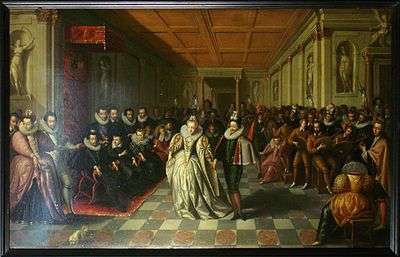Anne de Joyeuse
.jpg)
Anne de Batarnay de Joyeuse, Baron d'Arques, Vicomte then Duke of Joyeuse (1560 or 1561 – 20 October 1587) was a royal favourite and active participant in the French Wars of Religion.
An intimate friend of Henry III of France, he was known as a minion and keeper of the king's chambers, with these serious responsibilities he also gained a number of privileges around the court such as wearing royal colors such as royal blue, purple, and red, also the right to wear jewelry of high majesties of the court such as a well known red ruby and diamond ring given to him by the king after having been taken away from Princesse Marguerite de Valois as a punishment for accusing Anne of trying to interfere with a meeting with a king as requested of her by Catherine de' Medici, he was also a member of the circle of young courtiers known as Les Mignons.
Anne was born in 1560 in the château de Joyeuse. He was the eldest son of Guillaume, 8th Vicomte de Joyeuse, the owner of the rights to the Bishopric of Alet and future Marshal of France. Cardinal François de Joyeuse was his younger brother. He was reared in Toulouse and attended the Collège de Navarre, starting in August 1572.

From 1577 onward, Anne accompanied his father in the annual expeditions against the Huguenots to Languedoc and Auvergne. In 1579, he was put in charge of a compagnie d'ordonnance and was soon appointed governor of Mont Saint-Michel. In 1580, he took part in the siege of Fère-en-Tardenois.
The King arranged Joyeuse's marriage to his sister-in-law, Marguerite, daughter of Nicholas, Duke of Mercœur. The nuptials were celebrated on 18 September 1581 with unprecedented magnificence. King Henry used the marriage as a pretext for elevating his favourite to the dignity of Duc de Joyeuse. He was given precedence over all other dukes and peers of France, with the exception of princes of the blood. In addition to more than 300 000 écus in dowry, he was given the seigneury of Limours.
In the next year, the 21-year-old mignon was made Grand-admiral de France (1 June) and commander in the Order of the Holy Spirit, the kingdom's highest (31 December). He was appointed governor of Normandy in 1583 and Le Havre in 1584. After the death of Duke François the Joyeuse brothers were allowed to govern the duchies of Anjou and Alençon in the name of the king.
His massacre of 800 Huguenots during a campaign in Poitou (the massacre de Saint-Eloi, 21 June 1587) incurred the displeasure of the King. He was received coldly at court and, anxious to be restored to Henry's favour, led royal troops against the king's arch-enemy, Henry of Navarre. He suffered a defeat at the hands of the Huguenots in the Battle of Coutras and was taken prisoner. Although he offered a ransom of 100,000 écus, Joyeuse was killed in revenge for the massacre of Saint-Eloi, as was his 18-year-old brother Claude, lord of Saint-Sauveur. He was childless and was succeeded as Duke of Joyeuse by another brother, François.
References
| Wikimedia Commons has media related to Anne de Joyeuse. |
- Pierre de Vaissière, Messieurs de Joyeuse (1560-1615), Paris, Albin Michel, 1926. 352 p.
- François Puaux, Histoire de la Réformation française, tome II, Paris, Lévy, 1859.